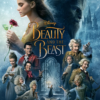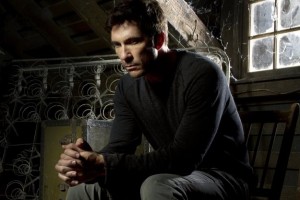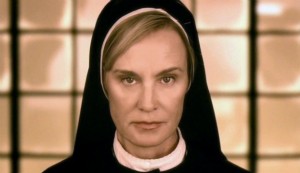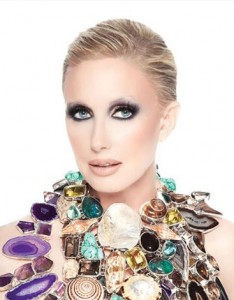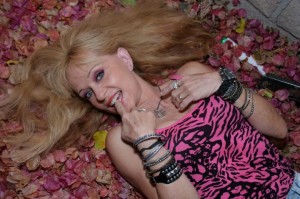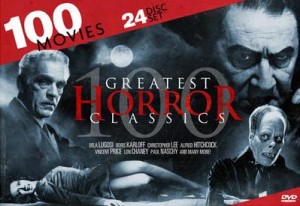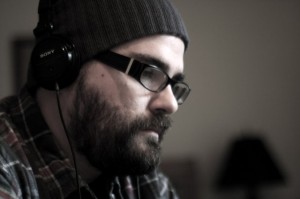Lily Rabe is known best for her role in FX’s series “American Horror Story”. In the first season she played the character Nora Montgomery and in the second she played the devil-possessed nun, Sister Mary Eunice. As the show approaches the end of its second season, Lily took out some time to chat with Media Mikes about her character and her fate at the end of the season.
Mike Gencarelli: What did you find the most difficult part of your role this season?
Lily Rabe: Well, you know, I think some of the murders having sort of in those moments where she was just absolutely sort of in her completely taken over by the devil and throwing these actors around and slitting their throats and stabbing them ruthlessly and all of that sort of, you know I’ve been the victim a lot, so I’ve often played the person who’s getting raped or murdered or abused. And so to actually be raping and murdering and abusing people is a whole different kind of challenge and one that it was very difficult at times and sometimes I would sort of go home from work and just kind of stare at the wall for a couple of hours. But I can’t complain, because easily if whatever kind of knocks you out working is the kind of work that I want to be doing because it’s always those challenges that are the most exciting and the things I hope to get to keep doing in my work.
MG: How did you approach your role because I feel that the combination of comedy and horror and I’m wondering if the director somehow guided you on how to play the devil in your character?
LR: Yes, you know the truth is the way that I approached it really was to figure out before we started shooting the most important thing to me was to really figure out who Sister Mary Eunice was and not really worry about the possession or the devil because to me so much of what a possession is is specific to the person. So that to play the sort of dark side or underbelly of someone or their sort of shadow taking over it’s really about knowing who that person is before that event has taken place of this dark thing sort of taking over. So it was more about figuring out who she really was through and through.
MG: There are many different storylines this season, was there any one that was your favorite?
LR: You know my storyline with Jessica (Lange) was perhaps the most powerful to me because I think it’s sort of the most tragic in a way because it’s actually the one that involved the most love, even though there was a sort of, even though Jessica’s Jude is very cruel to Eunice in the beginning. I always believed that that cruelty was coming out of a place of love and a place of sort of seeing Mary Eunice as seeing her potential and knowing that she wasn’t living it. And so in a way that that whole where we started and where we ended up, that to me is probably the one that was the most sort of powerful; but I have to say all of, you know, my relationship with James and with everyone, everyone I got to sort of work with. I even had a great side plot with Spivey. Mark Conseulos is so amazing and it was such an abundance of amazing actors that you get a chance to work with while you’re doing the show.
MG: Was there anything this season that really has surprised you or threw you for a loop when you saw the episode completed for the first time?
LR: Well, there are certain points of things that are going to happen to you; but there was a lot of mystery and a lot of sort of you have to be constantly taking a tremendous leap of faith and just sort of staying present in the moment of whatever the scene is, because you don’t know exactly you know where that turn is going to end up or what the next episode is going to bring. You know you have these sort of landmark things that you know about, but within the sort of nuance of the storylines. There was a certain amount of mystery. I didn’t watch the show while it was airing because it was too hard to be shooting episode three or I mean the episode seven and watching episode three or however it worked out. My brain was getting really scrambled, but I had to wait till the season had wrapped because there is in the same way that the audience is being surprised, you know we were definitely getting our handful of surprises, too, that’s for sure.
MG: What was it like at the Asylum itself can almost be looked at as a character on the show. What was the atmosphere like on set to work in an environment like that?
LR: Right, I know it is a dark world to live in, but I think the thing that made it so, still so kind of wonderful and a place that I was excited to drive to work every morning and that was because of the people and the crew. It was a very close group of actors and the writers are very, it’s an amazing group of writers. I think Ryan has a way of when he’s at the helm he’s one of those people who just creates a great work environment. I think it’s so much about that person. The leader really has to set the tone for something and make everyone feel safe and he does that in such an incredible way and so everyone, although we were maybe working crazy hours and shooting crazy things, it was always a really nice place to go to work. And for me you know it was the first time I’d ever been, I’ve never done a show as a regular before and it reminded me a bit of doing a play in the sense that you go to the theatre every day and you have your dressing room. And you have the crew and the actors and so I loved that feeling of actually kind of having this family every day that was sort of new for me and very special.
MG: Was there anything that you guys did to break up the tension in between a scene that would be particularly intense?
LR: Oh well, I mean you know Sara Paulson is one of my best friends and has been for years. We already have a bit of laughing problem together, so I would say that that happened a lot. There was often a lot of that and Zach was learning the banjo and I was learning the guitar, so there were also little musical breaks, although he’s much better at the banjo than I am at the guitar at this point.
MG: Did you ever have times that it was hard to deal with the character because of the psychological heaviness of the role?
LR: Yes, but it sort of came with the territory in the sense that I think if you’re going to be; I feel that with all the great jobs or all the really, really great parts, you’re usually going to sort of dark and scary or painful places and that’s just part of it. Although it could be difficult in some way, it sort of comes with, it’s part of the job description I feel, so it’s nothing I would ever sort of want to say was a negative, even though sometimes it doesn’t feel great. It’s sort of to me it’s still part of the job description of getting to play a wonderful role and having to go through things like that. So I’m always very grateful for that even if it means I’m going to go have to kind of collapse in my bed for a little while or whatever or whatever it means.
MG: How far in advance did you know what your character’s fate was going to be? Did you kind of have an idea about that from the beginning?
LR: I had some sense, yes, I knew that she probably wouldn’t have a very happy ending, so I did have a sense and then sort of as we went along the specifics of how that was all going to happen became clearer as we went along.
MG: That scene almost seemed like kind of a relief for your character. Can you reflect?
LR: Yes, I think the death scene, the way Ryan and I really talked about it it’s really sort of an assisted suicide. Her situation really wasn’t survivable in the sense that even if they had done some sort of exorcism or something at that point, we sort of felt that whatever might be left of that girl was so damaged and destroyed and that death sort of became her only way out. Yes, playing that through once the possession happened that was such a wonderful challenge and a sort of dance really to live between with both the lightness and the darkness existing at the same time in that battle and then that losing battle really.
MG: Do you think you will be back for the third season?
LR: I have no idea. I can’t say a word. I’m so sorry. I know it’s such a boring interview sometimes with us at American Horror Story, so that I just can’t say a word. I would certainly love to be back that’s for sure. It’s such a great job.
Related Content
- Lizzie Brocheré reflects on her role in “American Horror Story: Asylum”
- Mark Margolis talks about his role in “American Horror Story: Asylum”
- Chloë Sevigny talks about co-starring in FX’s “American Horror Story: Asylum”
- Morgan Fairchild talks about Syfy’s “American Horror House”
- Evan Peters talks about his role in FX series “American Horror Story”
